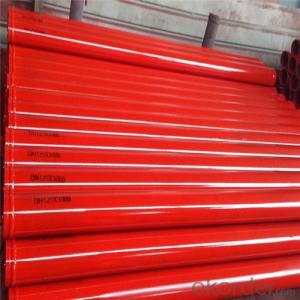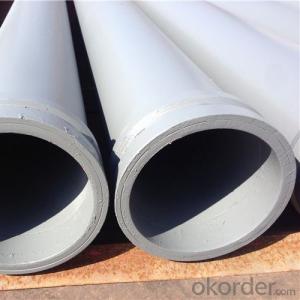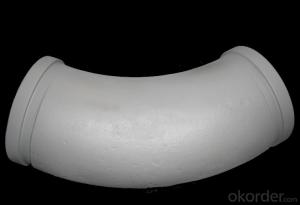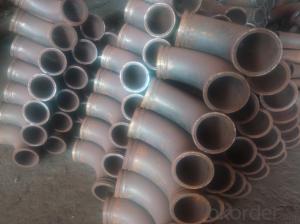Concrete Pump ELBOW R275, 90DGR DN125MM with High Quality
- Loading Port:
- Tianjin
- Payment Terms:
- TT or LC
- Min Order Qty:
- 5 pc
- Supply Capability:
- 10000 pc/month
OKorder Service Pledge
OKorder Financial Service
You Might Also Like
Product Name: Concrete Pump ELBOW R275, 90DGR DN125MM
1. Specification
Dimensions: DN100MM
Radius: 275mm,1000mm
Flange: SK, ZX, F&M
Degree: 30°, 45°, 90°
Material: #20 steel, ST52, Mn 13-4
Thickness: 4.5mm,6mm,7.1mm,7.5mm,10mm,
Working pressure: 180MPa
Notes: total series of concrete pump clamp for different brand concrete pump(PUTZMEISTER, SCHWING, CIFA, SANY, ZOOMLION, IHI, KYOKUTO Etc) available from us.
2. Application of Concrete Pump Bend DN125
Concrete Pump ELBOW R275, 90DGR DN125MM widely used on concrete pump truck, concrete placing boom, trailer concrete pump etc, for concrete delivery pipe connection.
Our concrete pump bends have been successfully exported to many countries from 1998, Our main markets as below: Middle East, Southeast Asia, America, Brazil, Italy, Russia, South Africa etc
Aiming at the largest concrete pump parts manufacturer, and reliable, professional supplier in China, we can supply concrete pump elbows, delivery pipes, casting or forging couplings, end rubber hoses, rubber pistons, tungsten wear plates, delivery cylinders, and other hydraulic parts, one stop service for your concrete pump parts and accessory business.
3. Package and Delivery of Concrete Pump Bends
Every 60pcs Concrete Pump ELBOW R275, 90DGR DN125MM put in one seaworthy wooden box, and 20 boxes in one 20feet container.
FAQ:
Q1: Why buy Materials & Equipment from OKorder.com?
A1: All products have its ISO certifications, adheres to the highest standards and a commitment to supply chain safety and customer satisfaction.
Q2: How do we guarantee the quality of our products?
A2: We have established an advanced quality management system which conducts strict quality tests at every step, from raw materials to the final product. At the same time, we provide extensive follow-up service assurances as required.
Q3: How soon can we receive the product after purchase?
A3: Within three days of placing an order, we will begin production. The specific shipping date is dependent upon international and government factors, but is typically 10 to 30 workdays.
Q4: If we can produce some Concrete Pump Concrete Pump ELBOW R275, 90DGR DN125MM according to customers request?
A4: Yes, we can produce Concrete Pump ELBOW R275, 90DGR DN125MM according to the difference country situations and different concrete pump to make it suitable to the market and customers. We have very professional technical team to make the design.
Q5: How to make a quick resolution for after service?
A5:We have overseas branches all-around of world, IF needed, the seller shall dispatch 2 engineers to the buyer's site for supervision of training. The buyer shall make available of necessary facilities &skilled personnel at site for training.
Images:



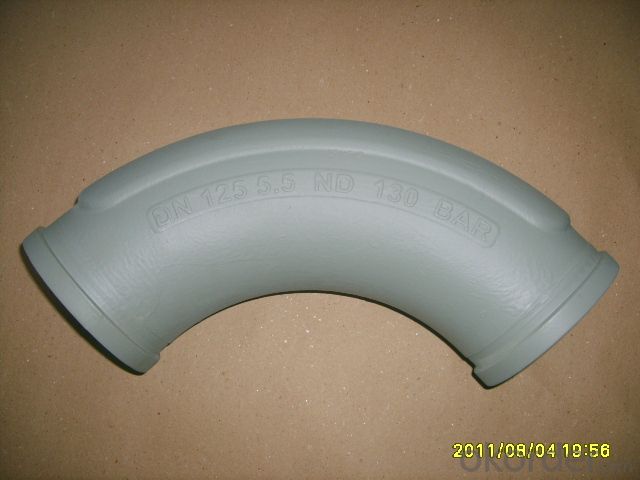
- Q: Can I get spare parts for both concrete pumps with and without boom stabilizers?
- Yes, you can get spare parts for both concrete pumps with and without boom stabilizers.
- Q: Are there any specific guidelines for the installation of wear plates or cutting rings in concrete pump spare parts?
- Yes, there are specific guidelines for the installation of wear plates and cutting rings in concrete pump spare parts. These guidelines are important to ensure the proper functioning and longevity of the pump. 1. Firstly, it is important to clean the surface where the wear plate and cutting ring will be installed. Any debris, dust, or old material should be removed to ensure a smooth and secure fit. 2. The wear plate and cutting ring should be inspected for any damage or defects before installation. Any parts that are worn out or damaged should be replaced to avoid any potential issues during operation. 3. Apply a thin layer of lubricant or grease to the surface where the wear plate and cutting ring will be installed. This will help with the alignment and ease of installation. 4. Carefully align the wear plate and cutting ring with the designated slots or grooves in the concrete pump. It is crucial to ensure that they are accurately positioned to avoid misalignment or premature wear. 5. Use appropriate tools or equipment to secure the wear plate and cutting ring in place. This may involve tightening bolts, screws, or other fasteners. It is important to follow the manufacturer's instructions and torque specifications to ensure proper installation. 6. After installation, perform a visual inspection to ensure that the wear plate and cutting ring are securely in place and properly aligned. Any signs of misalignment or loose parts should be addressed immediately. 7. Regular maintenance and inspection of the wear plates and cutting rings are essential to identify any signs of wear or damage. It is recommended to follow the manufacturer's recommendations for maintenance intervals and replacement schedules. By following these specific guidelines, you can ensure the proper installation and function of wear plates and cutting rings in concrete pump spare parts, leading to improved performance and extended lifespan of the equipment.
- Q: What is the role of a concrete pump spectacle plate?
- The role of a concrete pump spectacle plate is to provide a stable and secure platform for the concrete pump to rest on during operation. It acts as a support base for the pump, ensuring that it remains steady and balanced while pumping concrete. The spectacle plate is typically made of durable materials such as steel or alloy, capable of withstanding the weight and pressure exerted by the pump. Its design includes various features such as slots or holes to allow for the attachment of accessories like clamps or pipes, enabling the smooth and efficient transfer of concrete from the pump to the desired location. Additionally, the spectacle plate may also have adjustable elements to allow for positioning and alignment adjustments, ensuring accurate placement of the concrete. Overall, the spectacle plate plays a vital role in maintaining the stability and functionality of the concrete pump, contributing to the successful completion of construction projects.
- Q: How long do concrete pump pipes typically last?
- Concrete pump pipes typically last between 25,000 to 40,000 cubic meters of concrete pumped. However, the lifespan of these pipes can vary based on several factors such as the quality of the pipes, the type of concrete being pumped, the pumping pressure, and the maintenance practices followed. Regular inspections, cleaning, and proper storage can help extend the lifespan of concrete pump pipes. Ultimately, it is essential to monitor the wear and tear of the pipes and replace them when necessary to ensure efficient and safe concrete pumping operations.
- Q: How often should concrete pump hydraulic motors be inspected and replaced?
- Concrete pump hydraulic motors should be inspected regularly, ideally every 500 to 1000 hours of operation, to ensure they are in good working condition. However, the frequency of replacement depends on various factors such as usage intensity, maintenance practices, and the quality of the motor. Generally, hydraulic motors can last for several years if properly maintained, but if any signs of wear, leakage, or reduced performance are observed, it is recommended to replace them promptly to prevent potential breakdowns or accidents.
- Q: What are the fittings of concrete pump?
- The commonly used electrical accessories (button switch, switch, trip circuit breaker, transformer terminals, etc.), hydraulic pipe
- Q: How do I properly maintain and replace hydraulic filters in concrete pump spare parts?
- To properly maintain and replace hydraulic filters in concrete pump spare parts, follow these steps: 1. Regularly inspect the hydraulic filters for any signs of damage, clogs, or excessive dirt accumulation. 2. If the filter is damaged or excessively dirty, replace it immediately to ensure the proper functioning of the hydraulic system. 3. Before replacing the filter, ensure that the hydraulic system is depressurized to avoid any accidents. 4. Carefully remove the old filter and dispose of it properly. 5. Clean the filter housing thoroughly to remove any debris or contaminants. 6. Install the new hydraulic filter, ensuring that it is properly seated and secured in place. 7. Double-check that all connections and fittings are tight to prevent any leakage. 8. Once the new filter is in place, refill the hydraulic system with the recommended hydraulic fluid. 9. After replacing the filter, run the concrete pump and observe for any abnormal sounds, leaks, or pressure fluctuations. 10. Maintain a regular filter replacement schedule based on the manufacturer's recommendations to ensure optimal performance and prevent potential damage to the hydraulic system.
- Q: How can one determine the correct voltage and current rating for electrical components in concrete pump spare parts?
- To determine the correct voltage and current rating for electrical components in concrete pump spare parts, one should refer to the manufacturer's specifications, which are typically provided in the product documentation or labeling. It is essential to match the voltage and current requirements of the electrical components to ensure proper functioning and prevent any potential damage or hazards.
- Q: What is the purpose of a concrete pump control panel?
- The purpose of a concrete pump control panel is to provide operators with a centralized interface to control various functions and parameters of the concrete pump. This control panel allows operators to start and stop the pump, control the speed and direction of the pump, and monitor and adjust the flow and pressure of the concrete being pumped. It also provides safety features such as emergency stop buttons and alarms to protect both the operators and the equipment. Additionally, the control panel may include diagnostic features that display real-time data and alerts for maintenance and troubleshooting purposes. Overall, the purpose of a concrete pump control panel is to enhance efficiency, accuracy, and safety in the operation of the concrete pumping process.
- Q: What are the different types of concrete pump rubber pistons?
- In the market, one can find a variety of concrete pump rubber pistons, each with its own purpose and specifications. Commonly used types include: 1. Single-Action Piston: This piston is designed to push the concrete forward during pumping. It moves in one direction, ensuring a consistent and efficient flow of concrete. 2. Double-Action Piston: Unlike the single-action piston, this one can move in both directions. It offers more versatility in pumping, especially when there are obstacles or restrictions in the pump line. 3. Steel Reinforced Piston: To provide extra strength and durability, these pistons are reinforced with steel. They are often used for high-pressure pumping or when handling abrasive materials. 4. Polyurethane Piston: These pistons are known for their exceptional wear resistance and long lifespan. They are commonly used in demanding pumping conditions where durability is crucial. 5. Rubber Sponge Piston: Designed with a soft and flexible surface, rubber sponge pistons can conform to irregularities in the pump line. They are particularly useful for navigating bends or corners in the line. 6. Bonded Piston: Bonded pistons are created by bonding a rubber or polyurethane material to a metal core. This combination offers the flexibility of rubber and the strength of metal, making them suitable for a variety of pumping applications. Choosing the right concrete pump rubber piston is crucial for project success. Factors such as pumping pressure, material being pumped, and environmental conditions should be taken into account to ensure optimal performance and longevity of the piston.
Send your message to us
Concrete Pump ELBOW R275, 90DGR DN125MM with High Quality
- Loading Port:
- Tianjin
- Payment Terms:
- TT or LC
- Min Order Qty:
- 5 pc
- Supply Capability:
- 10000 pc/month
OKorder Service Pledge
OKorder Financial Service
Similar products
Hot products
Hot Searches
Related keywords










